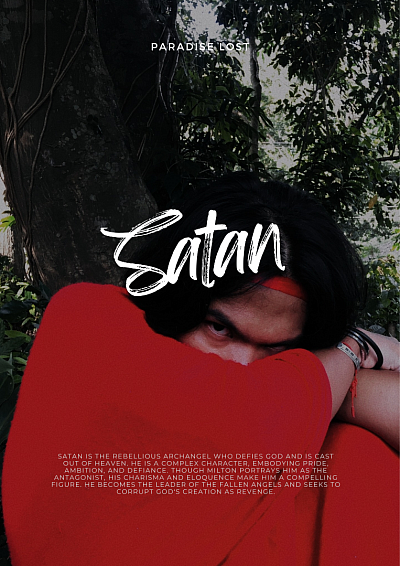Character Analysis
Satan
Satan, as portrayed in John Milton's Paradise Lost, is one of the most complex and compelling characters in literature, embodying themes of pride, ambition, rebellion, and the consequences of moral corruption. He is simultaneously a tragic antihero and the epitome of evil, serving as the primary antagonist in the poem. Through Satan, Milton explores profound questions about free will, the nature of sin, and the destructive power of unchecked ambition.
At the beginning of the poem, Satan is introduced as a fallen archangel, cast out of Heaven for leading a rebellion against God. His defining trait is his boundless pride, which fuels his refusal to submit to divine authority. Satan’s famous declaration, “Better to reign in Hell than serve in Heaven,” captures his unyielding ambition and his preference for autonomy, even at the cost of eternal suffering. This statement highlights the central theme of free will and its misuse, as Satan’s rebellion stems from his desire for self-rule and equality with God, despite his created nature.
Satan’s leadership qualities and rhetorical skill make him an intriguing and charismatic figure. He inspires his fellow fallen angels with speeches filled with resolve and defiance, portraying himself as a heroic figure standing against tyranny. However, this image is deceptive, as Satan’s rebellion is motivated not by a noble cause but by his insatiable pride and envy. Milton uses Satan’s oratory to illustrate the seductive power of rhetoric and its ability to mask moral corruption. Despite his compelling words, Satan’s actions consistently reveal his selfishness and deceit, as he manipulates others to achieve his goals.
A key aspect of Satan’s character is his internal conflict and psychological depth. Throughout the poem, Satan is plagued by moments of doubt, despair, and self-awareness. He acknowledges the futility of his rebellion and the misery it has brought upon himself and his followers. His famous soliloquy in Book IV, where he laments, “Which way I fly is Hell; myself am Hell,” reflects his internal torment and the inescapable nature of his suffering. These moments of introspection add a layer of tragedy to his character, as they reveal his awareness of the consequences of his choices, even as he persists in his defiance.
Satan’s cunning and resourcefulness are further demonstrated in his plot to corrupt humanity. His decision to target Adam and Eve is driven by a desire for revenge against God, as he seeks to undermine the Creator by tainting His most beloved creation. Satan’s temptation of Eve is a masterful display of manipulation, as he appeals to her vanity, curiosity, and desire for independence. His success in persuading Eve to eat the forbidden fruit underscores his role as the corrupter and brings the themes of temptation and the fallibility of human nature to the forefront.
Despite his grandeur and complexity, Satan’s character ultimately diminishes over the course of the poem. As he descends deeper into sin, his nobility erodes, and he becomes increasingly consumed by his own hatred and self-destruction. By the time he returns to Hell after corrupting Adam and Eve, he is grotesquely transformed into a serpent, symbolizing his moral and spiritual degradation. This transformation reflects Milton’s theological message that rebellion against God leads not to empowerment but to self-annihilation.
Satan’s role in Paradise Lost serves as a cautionary tale about the dangers of pride, ambition, and the rejection of divine order. While his charisma and complexity make him a compelling figure, Milton ultimately portrays him as a cautionary embodiment of moral failure. Through Satan, Milton examines the consequences of free will misused and the destructive power of unchecked ego, emphasizing the importance of humility, obedience, and alignment with divine will. Satan’s tragic arc reinforces the poem’s central theme: that true greatness lies not in rebellion, but in submission to the divine order and the acceptance of one’s place within it.
Sin
Sin, in John Milton’s Paradise Lost, is a personified allegory that embodies the concept of moral transgression and its consequences. As the offspring of Satan and a key figure in the infernal realm, Sin’s character symbolizes the corrupting and self-perpetuating nature of disobedience and rebellion against divine order. Through Sin, Milton explores themes such as the origins of evil, the destructiveness of sin, and its inextricable link to suffering and death.
Sin is first introduced at the gates of Hell, where she and her son, Death, guard the entrance. Her appearance is both grotesque and tragic, reflecting her role as a manifestation of moral corruption. She is described as a female figure with a lower half resembling serpents and a body that perpetually spawns hellhounds, which return to devour her entrails in a cycle of torment. This horrifying imagery illustrates the destructive and self-consuming nature of sin, emphasizing its cyclical relationship with pain and suffering.
Milton provides Sin with a disturbing origin story that ties her directly to Satan and the Fall. She is born from Satan’s head during his rebellion against God, a grotesque parody of divine creation. This birth symbolizes the intrinsic link between pride, rebellion, and sin. Her incestuous union with Satan produces Death, creating a twisted familial trinity that parodies the Holy Trinity. The relationship between Sin, Death, and Satan reflects the progression of evil: rebellion against God (Satan) leads to sin (Sin), which ultimately results in death (Death). This dynamic encapsulates Milton’s theological assertion that sin inevitably leads to destruction.
Sin’s relationship with Satan is complex, marked by both loyalty and victimhood. She aids Satan by opening the gates of Hell, allowing him to embark on his journey to corrupt humanity. Her willingness to assist him reflects her alignment with his rebellion, but her existence as a tormented being also portrays her as a victim of Satan’s ambition and the consequences of his actions. Milton uses Sin’s character to demonstrate how sin, once unleashed, enslaves and perpetuates suffering, ensnaring both its creators and its victims.
Sin’s role in the narrative extends beyond her allegorical function; she also serves as a narrative link between the infernal and mortal realms. By opening the gates of Hell, she facilitates Satan’s passage to Earth, setting in motion the events that lead to humanity’s fall. This act underscores the idea that sin is a gateway to further corruption and separation from divine grace. Her role as a gatekeeper symbolizes how sin grants access to a state of existence defined by alienation from God and the perpetuation of suffering.
While Sin is a secondary character in Paradise Lost, her presence is deeply symbolic and integral to the poem’s exploration of theological themes. She personifies the consequences of rebellion against God, illustrating how sin originates from defiance and leads to suffering and death. Her grotesque and tragic depiction serves as a stark warning about the destructive power of moral transgression and its ability to corrupt and consume.
Ultimately, Sin’s character is a grim reflection of the broader consequences of disobedience and the perversion of divine order. Through her, Milton reinforces the moral and theological framework of the poem, demonstrating that sin is not only a transgression against God but also a self-destructive force that perpetuates suffering and alienation. Sin’s existence as a being both repellent and pitiable highlights the dual nature of sin as both a chosen act and an inescapable consequence, further enriching Milton’s complex portrayal of the fallen world.


